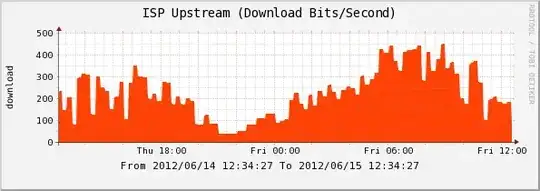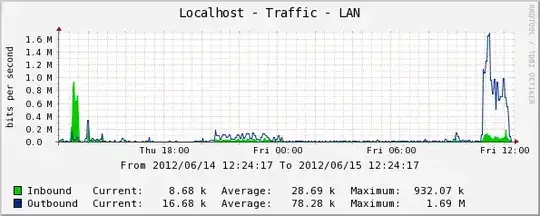I have been arguing with my ISP about the service they are providing; primarily with regard to throughput speeds.
I have set up an edge router (see hardware details listed below) and on it I have set up the following test to get speeds periodically (via cron):
wget --no-cache --output-document=/dev/null -a /opt/result.txt http://speedtest.wdc01.softlayer.com/downloads/test10.zip
Cacti is set up and configured to ingest the output from this script and present it directly with no apparent modifications. (I'm a cacti newbie.)
Cacti also has graphs configured to show traffic in/out bps for both interfaces and here is where my question lies (lay?) ... Here's where I'm confused:
Earlier the speeds were testing at ~200 Kb/s. Not great.. not dead.

But when I look at the traffic bps inbound (download) it was showing max rates > 1.4 Mb/s.

How do I read these two seemingly contradictory pieces of data to make an accurate statement?
Did I misconfigure my reporting graphs somewhere or am I just misunderstanding what I have in front of me?
Hardware --
Dell PRECISION WS340
Linux servername 2.6.18-308.8.1.el5 #1 SMP Tue May 29 14:57:06 EDT 2012 i686 i686 i386 GNU/Linux
# WAN Port
eth0 Link encap:Ethernet HWaddr 00:06:5B:DD:37:D9
inet addr:192.168.100.100 Bcast:192.168.100.255 Mask:255.255.255.0
inet6 addr: fe80::206:5bff:fedd:37d9/64 Scope:Link
UP BROADCAST RUNNING MULTICAST MTU:1500 Metric:1
RX packets:17738847 errors:0 dropped:0 overruns:0 frame:0
TX packets:19695910 errors:0 dropped:0 overruns:0 carrier:1
collisions:0 txqueuelen:1000
RX bytes:188062544 (179.3 MiB) TX bytes:1467340085 (1.3 GiB)
Interrupt:201 Base address:0xc800
# LAN Port
eth1 Link encap:Ethernet HWaddr 00:1A:70:14:0F:40
inet addr:192.168.3.1 Bcast:192.168.3.3 Mask:255.255.255.252
inet6 addr: fe80::21a:70ff:fe14:f40/64 Scope:Link
UP BROADCAST RUNNING MULTICAST MTU:1500 Metric:1
RX packets:17502568 errors:1 dropped:0 overruns:0 frame:1
TX packets:12613687 errors:22 dropped:0 overruns:0 carrier:22
collisions:0 txqueuelen:1000
RX bytes:1453811807 (1.3 GiB) TX bytes:31429096 (29.9 MiB)
Interrupt:193 Base address:0x2c00